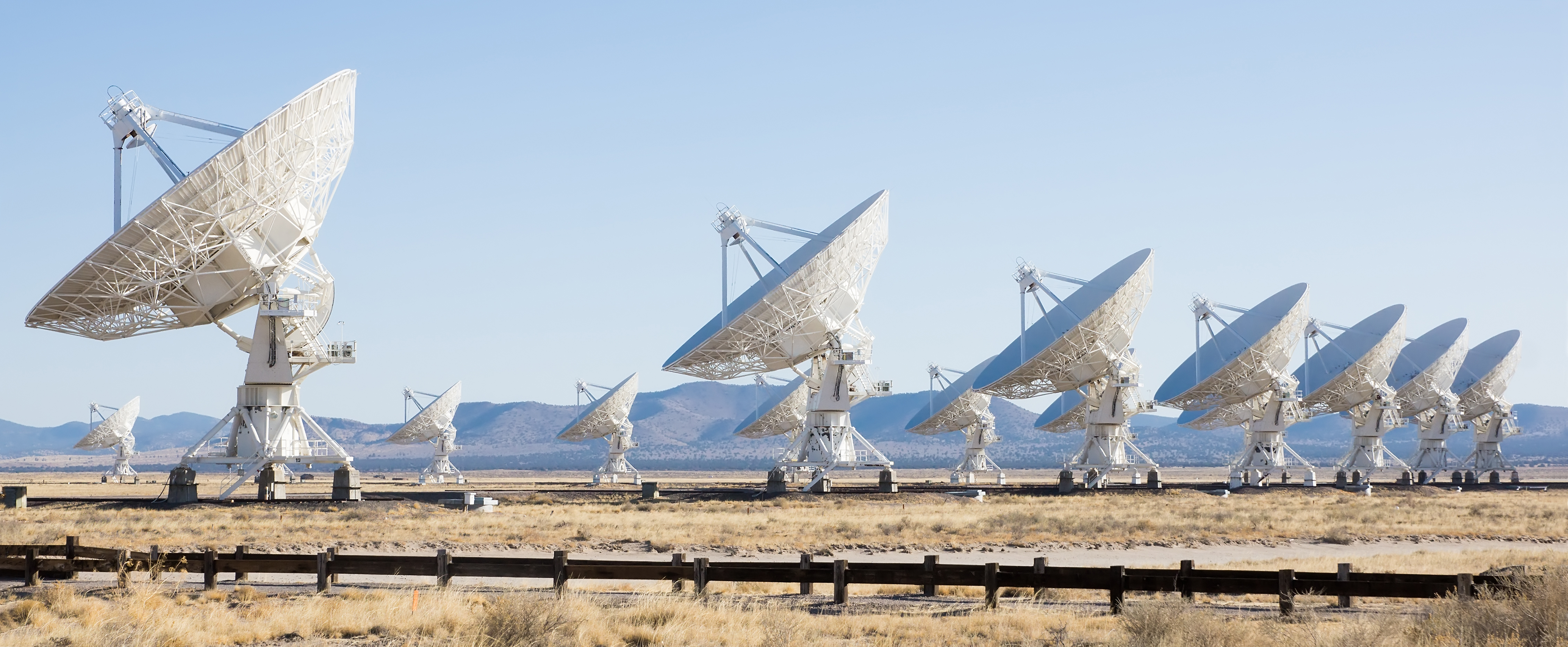Radioastronomy, Listening to the Stars

There are just four ways astronomers can study the Universe: by looking at physical objects (such as meteorites), elementary particles (such as cosmic rays), gravitational waves, and electromagnetic radiation (such as optical light).
Optical light, the radiation we’re able to perceive with our eyes, isn’t the only form of electromagnetic radiation. Astronomers observe the Universe through all parts of the electromagnetic spectrum, from radio waves, infrared radiation, optical light, and ultraviolet radiation to X-rays and gamma rays. The difference between these types of radiation is their wavelength or frequency. Radio waves have very long wavelengths while gamma rays have very short wavelengths.
Each region of the electromagnetic spectrum has its advantages and disadvantages for the astronomer, and each requires its own techniques and instrumentation. However, to fully understand many of the processes at play in the Cosmos, it is often necessary for astronomers to take a “multi-wavelength” approach.
Radio astronomy refers to the technique of receiving and interpreting radio waves—radiation of wavelengths between about 10 meters and 1 millimeter. Radio waves and optical light are the only two forms of radiation in the electromagnetic spectrum that can penetrate the Earth’s atmosphere. But, unlike optical light, radio waves can travel straight through the clouds of gas and dust that permeate the Cosmos. It is not surprising then that in the few decades that radio astronomy has existed, the technique has revolutionized our understanding of the Universe.
Radio waves originating from space were first discovered in 1931 by Karl Jansky, an engineer at the Bell Labs in New Jersey. Surprisingly, Jansky’s discovery went almost unnoticed by astronomers of the day. However, Grote Reber, a fellow radio engineer and amateur astronomer, was curious about Jansky’s discovery. In 1937, Reber built the world’s first radio telescope in his backyard in Wheaton, Illinois. In 1938, he confirmed Jansky’s discovery, and he went on to discover several radio sources in the 1940s.
Today, radio observations are an important tool for astronomers. During the discipline’s short history, radio astronomers have revealed the structure of the Milky Way, probed the inner workings of stellar nurseries, discovered ravenous black holes devouring the cores of galaxies, and detected the fading echo of the birth of the Universe. But that’s not all. Radio astronomy techniques have produced astronomical images of the greatest resolution (or detail) of any subfield of astronomy, in addition to enabling the detection of the faintest object ever seen.
Radio telescopes work on the same principle as optical telescopes. They generally consist of a paraboloid reflecting surfaces (like a mirror), which gathers incoming radiation and focuses it to a single point. The radio waves are picked up by a receiver, which amplifies them and converts them to an electrical signal that can be recorded and analyzed.
Although radio telescopes can be ten times bigger than optical ones, radio telescopes work at wavelengths 10,000 times longer. Since the resolution of a telescope depends on both its diameter and the wavelength, achieving the same resolution as a typical optical telescope would require a radio dish many hundreds of kilometers wide. This means the world’s largest fully steerable radio telescope, the 100-meter Green Bank Telescope (GBT), has a resolution no better than the human eye.
To deal with the problem of resolution and achieve better results, radio astronomers often combine several radio antennas in an instrument called an interferometer. In fact, by linking telescopes across whole continents, radio astronomers have achieved the highest resolution in all of astronomy—equivalent to spotting a quarter coin on the surface of the Moon!
Radio waves from space are extremely weak. The total amount of energy received by all of the world’s radio telescopes since they were first turned to the heavens is less than that required to light a 1-Watt light bulb for 1 second. You use a million times this energy every time you boil a kettle!
There are various mechanisms by which astronomical objects emit radio waves. At long wavelengths, the emission occurs primarily from high-energy particles moving in strong magnetic fields, such as those found in pulsars, supernova remnants, radio galaxies, and quasars. At short wavelengths, the emission is dominated by thermal sources like the gas and dust clouds of the interstellar medium.
The Sun and planets emit relatively small amounts of radio energy. The Sun produces radio waves in the hot plasma suspended in the corona. Jupiter produces radio waves by trapping energetic particles from the solar wind in its intense magnetic field.
Further afield, all sorts of stars—hot and cool, large and small—are strong radio sources. Some produce radio waves in the same way as the Sun, others generate emissions with hot accretion disks. Supernova remnants, the interstellar medium, and gaseous nebulae also radiate in the radio range.
Just like the optical spectrum, the radio region is littered with spectral lines, most notably from molecules such as water, ammonia and hydroxyl. Some molecules in star formation regions produce “masers”, the microwave equivalent of lasers, that beam out of the dense dust and gas clouds.
Galaxies are by far the celestial objects that emit the most intense radio signals. The centers of many galaxies are believed to contain supermassive black holes, which are perhaps 100 million times the mass of the Sun. These active galactic nuclei (AGNs) devour stars and gas at a phenomenal rate; this results in highly energetic jets moving outwards from the galactic center at colossal speeds. The high velocity of the material and the high-intensity magnetic fields in these regions produce very strong radio emissions.
Quasars, perhaps the most notable discovery made in radio astronomy, are the most distant, fastest receding, and most energetic objects in the Universe. They are thought to be powerful AGNs, common in the early Universe, in which jets of material are directed almost towards the Earth.
In 1963, two radio engineers discovered that blank sky is not totally dark in the radio frequency range. Instead, the Universe is bathed in a uniform, faint radio hiss known as the Cosmic Microwave Background (CMB), which is the cooling remnant of the Big Bang. Through observations of the CMB, radio astronomers have helped to answer some crucial questions about the structure and evolution of the Universe.
Since their discovery in 1967, pulsars have provided radio astronomers with many intriguing questions. Pulsars are highly magnetized, rapidly spinning neutron stars, which are the collapsed cores of dead stars. Their radio emission is funneled through the magnetic poles. When one of these beams crosses the Earth, we see a sharp pulse of radio emissions, like a cosmic lighthouse.
Although radio astronomers are able to achieve the highest resolution in astronomy, the sensitivity of their instruments has for many years lagged behind those of astronomers who work with other wavelengths. But this is about to change. The discipline is currently undergoing a revolution, one that’s driven by the digital and telecommunications advances of the last decade. Telescopes will soon be connected with fiber optics to form supersensitive networks on a global scale. There are also plans for a major new instrument, the Square Kilometer Array, which will allow us to see deeper into the Universe than ever before.







